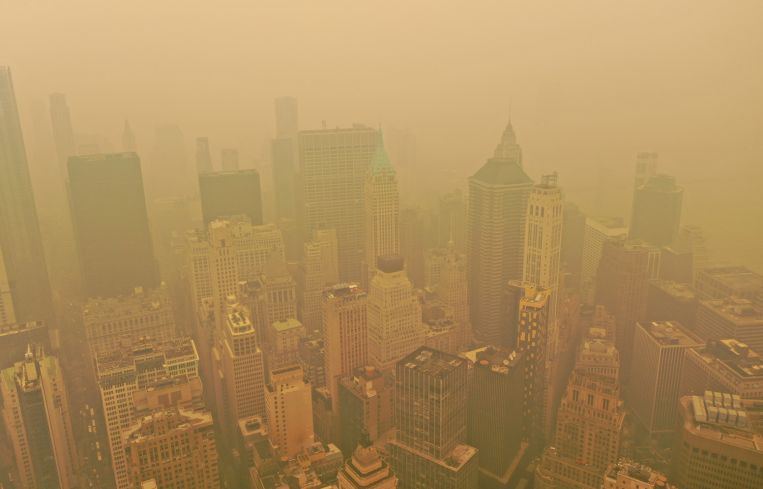Thank You For Not Smoking: The Effort to Smoke-Proof Medical Facilities
By Aaron Short August 21, 2023 8:00 am
reprints
When emergency room physician Mirtha Macri was getting off an overnight shift one weekday morning in early June, she noticed a rise in patients coming to Lenox Health Greenwich Village with asthma symptoms, chest pains, and difficulty breathing.
Soon, she understood why: a smoky haze had enveloped the region, the result of hundreds of wildfires ravaging 25 million acres of Canadian wilderness. She said the hospital saw a 15 percent jump of patients with cardiopulmonary complaints and allergies compared with the hospital’s daily average as New York City’s air quality plummeted from “unhealthy for sensitive groups” to “hazardous” levels.
Macri could smell the acridness of the smog inside the hospital, too, and her concerns around New York City’s air quality soon transferred to her home life as well as her profession. She didn’t run outside for a few days when the city’s air quality index levels were high and kept her small children indoors.
“I wanted to protect myself from this air quality,” she said. “We don’t know the long term effects of asthma and respiratory issues can pop up at any time. You’re not necessarily born with these conditions or develop them during childhood. I’ve seen adults well into adulthood come into the ER with severe repository symptoms.”
Northwell and other New York hospitals considered the smoke incident a one-time event and acted accordingly. Medical centers had already stockpiled an abundant supply of albuterol and other medicines meant to treat asthma and smoke inhalation. In some facilities, air handlers shut off and recirculated indoor air. Northwell also recommended staff and visitors wear masks and limit leaving the building to prevent smoke from seeping inside.
But the increased severity of Canadian wildfires from drier hotter summers and changing weather patterns due to climate change, not to mention the fires in Hawaii which have already claimed 111 lives as of Friday, means that smoke events could become more frequent in the northeast in the coming years.
Doctors in the northeast are already comparing notes with their colleagues on the West Coast, where fires are far more common.
“It’s hard to know because this is our first time dealing with [wildfires and the consequent air quality deterioration] but it could be going from acute problem to a chronic problem,” Katharine Miao, CityMD regional medical director, said. “Everyone’s mind is saying oh this is a one-off but if this happens again, there will be a lot more outreach to our colleagues out West for tips.”
If wildfires become a new reality for the east coast to deal with, hospitals will need significant preparation in advance of the next event. After all, stocking up on nebulizers is one thing, but changing the physical plant of a medical facility in response to chronic wildfires is quite another.
Oregon emergency rooms were already grappling with the coronavirus pandemic in the summer of 2020 when they suddenly had to treat a wave of new patients with asthma symptoms due to their exposure to smoke particles. The state’s wildfires eventually burned through more than 1 million acres and forced residents to cancel outdoor activities and stay indoors for nearly a month.
Oregon Health and Science University facilities director Roger Cole, who oversees three hospitals as well as outpatient centers and clinics in Portland, consulted with environmental health experts at the University of California to develop a tiered approach to cleaning indoor air through its building’s infrastructure and operations systems. That involved making their systems pull in outside air, filter particulates out through filters with high-efficiency grade filters, and recirculate the air indoors.
Ensuring that the filters are HEPA-grade or at least have a MERV rating of 10 and above, as well as upgrading fans with greater horsepower to pull more air in is tantamount to withstanding a poor air quality day, Cole said.
“It’s a very unusual experience to walk into a healthcare facility and smell smoke. It’s somewhat unsettling,” Cole said. “You can’t really visually see it in the air but you can smell a faint smoke smell. People really understood we need to do things to change our operations.”
Over the long-term, they may look to an electrostatic filter that can be installed in the building’s HVAC systems but that takes time to install. Instead, Cole said his team has been “tweaking around the edges” to make the indoor air cleaner.
One of their strategies was to restrict access to a hospital’s entry points by making the front door open manually as opposed to automatically, shut windows and close the dock door where their building receives shipments. But most of their budget went toward placing portable three-foot by three-foot air scrubbers with HEPA filters in waiting rooms where people were congregating or next to entrances that needed to stay open, to knock down the particulate count.
“It was helpful,” Cole said. “I chalk it up to doing every little thing that you can to minimize the amount of smoke coming into the building.”
Medical clinics in other parts of the state had to take similar off-the-cuff measures. Dr. Russell Massine, who practices at Summit Health clinics in Bend and Redmond, has been dealing with prolonged wildfire seasons since 2015. Capacity issues and limitations of the building’s HVAC systems remain the biggest challenges, but Massine sought to manage access to buildings, supply of medicines, and the demands of personnel during poor air quality days.
“Each building is subject to the quality of its HVAC system as well as its entry portal,” Massine said. “The ideal scenario is to use entrances with an air-lock quality or double doors, where you close one door and open another. We tried to purposely funnel patients and staff through them.”
In the meantime, the healthcare industry might have to re-evaluate how to keep hospital air clean during the days when the air outside is more dangerous than the air indoors.
“Our industry has been moving toward bringing more outside air into buildings because it’s healthier and historically in the past, buildings have used and recirculated air,” Cole said. The common knowledge is that more outside air is better, which goes against what we do in a smoke situation or a wildfire situation where we need to limit bad air that we need to bring into the building.”


